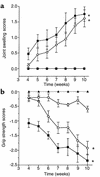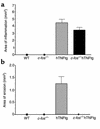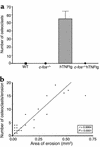Osteoclasts are essential for TNF-alpha-mediated joint destruction
- PMID: 12438440
- PMCID: PMC151809
- DOI: 10.1172/JCI15582
Osteoclasts are essential for TNF-alpha-mediated joint destruction
Abstract
The detailed cellular and molecular mechanisms leading to joint destruction in rheumatoid arthritis, a disease driven by proinflammatory cytokines, are still unknown. To address the question of whether osteoclasts play a pivotal role in this process, transgenic mice that express human TNF (hTNFtg) and that develop a severe and destructive arthritis were crossed with osteopetrotic, c-fos-deficient mice (c-fos(-/-)) completely lacking osteoclasts. The resulting mutant mice (c-fos(-/-)hTNFtg) developed a TNF-dependent arthritis in the absence of osteoclasts. All clinical features of arthritis, such as paw swelling and reduction of grip strength, progressed equally in both groups. Histological evaluation of joint sections revealed no difference in the extent of synovial inflammation, its cellular composition (except for the lack of osteoclasts), and the expression of matrix metalloprotein-ase-3 (MMP-3) and MMP-13. In addition, cartilage damage, proteoglycan loss, and MMP-3, -9, and -13 expression in chondrocytes were similar in hTNFtg and c-fos(-/-)hTNFtg mice. However, despite the presence of severe inflammatory changes, c-fos(-/-)hTNFtg mice were fully protected against bone destruction. These data reveal that TNF-dependent bone erosion is mediated by osteoclasts and that the absence of osteoclasts alters TNF-mediated arthritis from a destructive to a nondestructive arthritis. Therefore, in addition to the use of anti-inflammatory therapies, osteoclast inhibition could be beneficial for the treatment of rheumatoid arthritis.
Figures






References
-
- Scott DL, et al. The links between joint damage and disability in rheumatoid arthritis. Rheumatology. 2000;39:122–132. - PubMed
-
- Sack U, et al. Systemic characteristics of chronic arthritis induced by transfer of human rheumatoid synovial membrane into SCID mice (human/murine SCID arthritis) J Autoimmun. 1999;13:335–346. - PubMed
-
- Okada Y, et al. Localization of matrix metalloproteinase 9 (92-kilodalton gelatinase/type IV collagenase = gelatinase B) in osteoclasts: implications for bone resorption. Lab Invest. 1995;72:311–322. - PubMed
-
- van Meurs J, et al. Cleavage of aggrecan at the Asn341-Phe342 site coincides with the initiation of collagen damage in murine antigen-induced arthritis: a pivotal role for stromelysin 1 in matrix metalloproteinase activity. Arthritis Rheum. 1999;42:2074–2084. - PubMed
Publication types
MeSH terms
Substances
LinkOut - more resources
Full Text Sources
Other Literature Sources
Medical
Molecular Biology Databases
Miscellaneous

